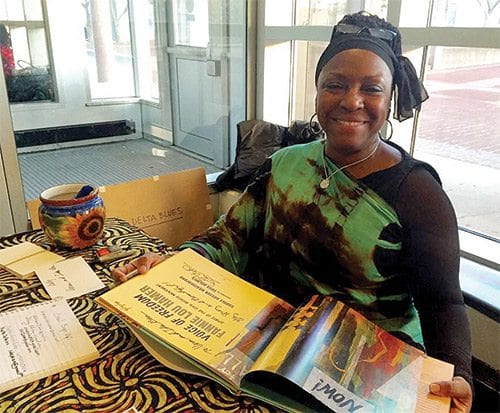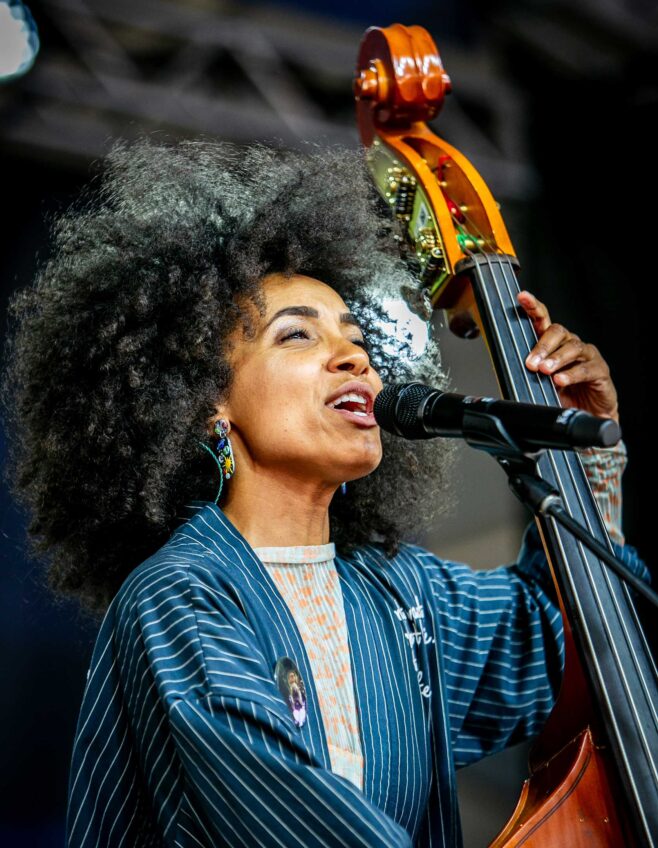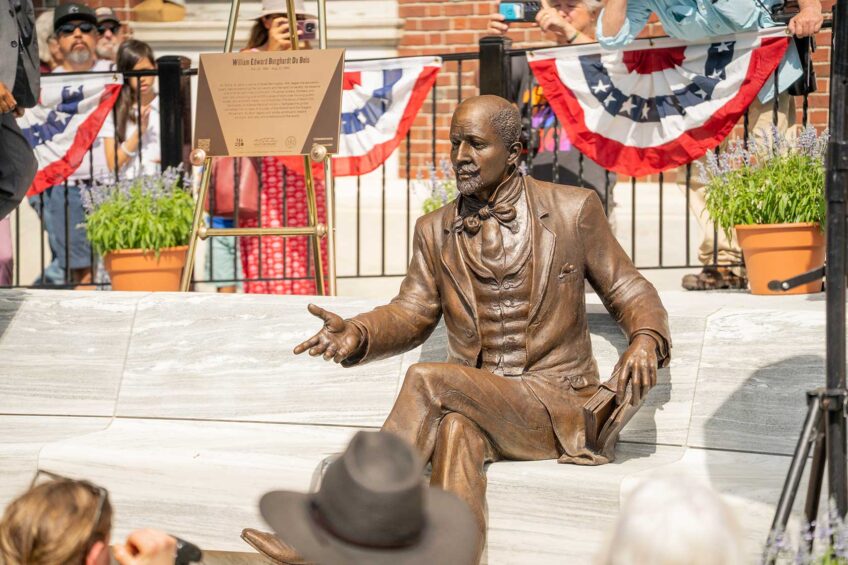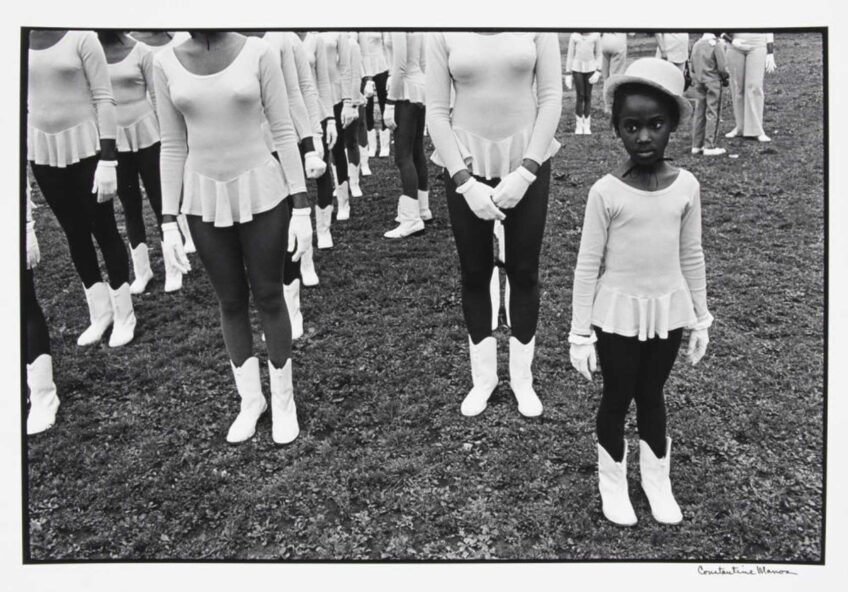Ekua Holmes’ ‘Deeply Rooted’ on display
Exhibit depicts South and Fannie Lou Hamer

Painter and collage artist Ekua Holmes has long championed the beauty, the uniqueness and the history of Roxbury and its residents through her collages and paintings. In her latest exhibit titled “Deeply Rooted,” the Roxbury native includes collages of civil rights activist/leader Fannie Lou Hamer, her grandfather, Comado Hendrix (in a captivating portrait titled “Idyll of the South: Root of Jesse”), as well as her father’s family members.
The illustrations of Hamer were initially created for the children’s book “Voice of Freedom: Fannie Lou Hamer, Spirit of the Civil Rights Movement,” written by Carole Boston Weatherford. Since its November 2015 release, Holmes’ illustrations have won several national and international literary awards, including becoming a 2016 Caldecott Honor Book, a 2016 Robert F. Sibert Honor Book, a 2016 Coretta Scott King/John Steptoe New Talent Illustrator Award Winner, and a 2015 Society of Illustrator’s Original Art Silver Award Winner.
Approached by Marshall Hughes, Arts and Media Director, and curator Mirta Tocci about holding a solo show at the Joan Resnikoff Gallery at Roxbury Community College, Holmes knew that she “wanted it to be something special.” As luck would have it, the illustrations from “Voice of Freedom,” were returned to her, and she knew that she wanted “to share them with this community.”
In a recent interview with the Banner via email (she had lost her voice prior to the interview), Holmes wrote about the significance of the exhibit’s title “deeply rooted,” her relationship with her grandfather, and what Fannie Lou Hamer represents to her.
What is the significance of “deeply rooted”?
Ekua Holmes: We are products of our environment. We are nurtured from the soil in which we are planted. Fannie Lou Hamer was born and lived in a place called Sunflower County, Mississippi. For me, sunflowers have long been a symbol of beauty born of rugged landscapes. Sunflowers find sustenance in places that seem barren. They are not easily pulled up or cut down because they are deeply rooted in the soil. Yet, they grow tall and bright. They bring great beauty and color to the earth. I think this is a great metaphor for Fannie Lou Hamer’s life and work. At the same time, the title also speaks to my own deep roots here in Roxbury, which have provided me with support and inspiration for much of my work.
You’ve done extensive research on Fannie Lou Hamer. Was there anything about her life that surprised you or that you uncovered during the research process?
EH: I was curious about how someone from a sharecropping plantation could grow up to be such a fearless woman, an amazing orator and gifted singer. I discovered that her mother’s influence was pivotal. She taught her to value herself as a black woman and to speak up for the weak. She also taught Fannie Lou those deep spiritual songs which she would become famous for singing at rallies and marches. I was also surprised to learn that she was in her 40s when she began her public life and work.
What does she represent for you?
EH: Courage, intelligence, faith, determination and spiritual beauty. Fannie Lou Hamer represents someone who with a child’s innocent eyes saw the world was not fair and questioned it. When the opportunity presented itself, she set about making a change. She never used being too old, too tired or too poor as excuses. She let her light shine.
I was very much drawn to the collage “Idyll of the South: Root of Jesse,” and it’s my understanding that Jesse is your grandfather. I was also told that as a child you would go to Arkansas for the summer and spend most of your time with him. Is he still alive and if so, has he seen this portrait? Did he influence your art in any way or how you see the world?
EH: The title of the piece, “Idyll of the South: Root of Jesse,” refers to a biblical scripture, Isaiah 11:1”There shall come forth a Rod from the stem of Jesse, and a Branch shall grow out of his roots.” Meaning that although a family or people be cut down to the stump, new life will spring from it. My grandfather, Comado Hendrix, provided me with love and attention during my summer visits to Arkansas. He took me horseback riding, fishing and always had a smile and patience for me. In my teens, he knew me as a young woman interested in photography. I would have my camera and he would pose for me as he did in the photo this collage is based on. When he lost his eyesight to diabetes, he gifted me with a box of photos dating back at least to the 1930s which included family and friends, including my mother and father. He was the loveliest man I ever met. Although he has passed away from this life, I wanted to honor him in a work of art.
Some of the other works in the exhibition are of my father’s family members who lived just one state over from Fannie Lou Hamer in Hope, Arkansas. They were having the same experiences with discrimination, violence and racial injustice. Working on this book put me in touch with that.
I noticed in many of your collages that despite the seriousness of the era in which the imagery depicts, there still seems to be a sense of hope and lightness shining through. Is this intentional and is this something you think about as you’re working on your collages?
EH: Yes. This was very intentional. As a work of literature for children, I felt that this book should speak truth but also uplift and inspire. Fannie Lou Hamer’s story is not a tragedy! It is a call to action for each of us to let OUR light shine in whatever way we can for the betterment of humanity. The palette of colors — deep greens, rich golds and browns — was meant to acknowledge the dire circumstances at the time as well as the hope and light of the times. Fannie Lou’s signature song “This little light of mine” is reflected in the clothing she wears in almost every collage — bright yellow like the sunflower.
After this exhibit closes will it be displayed elsewhere? What’s next for you?
EH: I love the possibilities in children’s literature for an artist! It is such an opportunity to learn. I am working on a second illustration project with Newberry winner, Kwame Alexander while looking at several other possibilities.
The current show is up until April 28, 2016. There are no current plans to display the work again in Boston, but I am open and hoping to tour the collection for up to a year. So many people, young and old do not know about Fannie Lou Hamer’s life and legacy. I thank Carole Boston Weatherford for writing this book and I want to do my part to share it.






